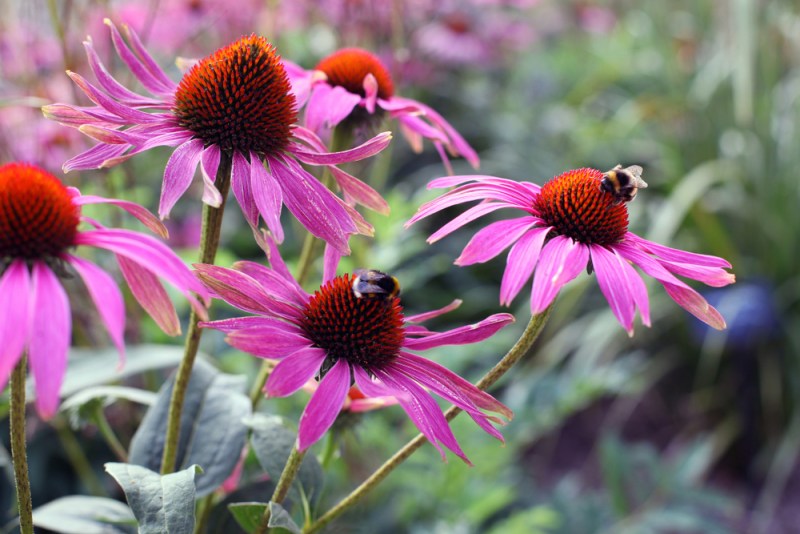Coneflowers are beautiful upright plants native to North America. They are the best of both worlds; hardy and low-maintenance, yet bright and nectar rich. They are a magnet for butterflies, hummingbirds, and honeybees all summer long. Coneflowers are drought and heat resistant, and their spiny core along with their strong scent are said to repel deer. They make great cut flowers adding height and color, while also making great border plants for your garden. Need more reasons to love and care for coneflowers? We’ve got you covered!
Planting Coneflowers

Shutterstock/Ovchar Anastasya
Where?
Coneflowers prefer well-drained soil and full sun for best bloom. Choose a location where the coneflowers won’t get shaded out nor shade out others. Coneflowers are very tolerant of poor soil conditions, but they perform best in soil that’s rich so mix in organic matter if needed.
When?
The most common way to plant coneflowers is by nursing small, store-bought plants with blooms already on the way. These, as well as mature divided plants, should be planted in spring or early summer. Coneflower seeds, should also be planted indoors a month before spring starts or outdoors when the soil temperature has reached at least 65°F/18°C. However, most gardeners have better luck sowing the seeds in the fall, to allow for cold stratification. This is the process by which the seed freezes and thaws multiple times to soften the coat and encourage growth.
How?
Start by loosening up the soil in your garden to 12 to 15 inches deep. Next mix in a 2- to 4-inch layer of compost. You’ll need to plant the coneflowers about 1 to 3 feet apart, depending on the size. If you are moving a potted plant into the ground, dig a hole about twice the pot’s diameter and bury the plant to the top of the root ball. You’ll need to water your plant thoroughly.
Growing And Caring For Coneflower Plants

Shutterstock/Mariia Boiko
Sun Exposure
Your plant will need full sun. While it can tolerate some shade, it may begin to lean toward or strain to reach the sun. Coneflowers need about 5-6 hours of full sun per day.
Water Requirements
Although coneflowers are drought-resistant, they will need regular watering after being first planted. You can slowly reduce the amount of water given every other week as it grows. After about two years, it will become self-sustaining and need very little watering.
Fertilizer Requirements
Too much supplemental fertilizer can cause them to have excessively long and straggly stem. They thrive in a soil mixture that is neutral and organic. Mulching the plants with compost each spring usually gives them the nutrition they need for healthy leaves and flowers.
How to Propagate And Cut Back Coneflowers
Your plant will benefit from cutting it back in late winter/early spring when you’re tidying up the garden. To encourage delayed blooming for fall enjoyment, cut coneflower plants back when plants come into bloom. This will result in later-flowering, more-compact growth because coneflowers can get leggy. Cut some and not others for more staggered bloom heights and times. Also, you’ll want to divide your plant every four years to separate clumps.
How To Prune or Winterize Coneflowers
It is common practice to dehead the plants to encourage repeat blooming, however, most plants will continue to produce flowers without cutting off the blooms. On the otherhand, by not deheading the plant, you are extending an open invitation for small animals to feed on your flowers. You may or may not want to begin this trend. Either way, coneflowers are very resilient and will bud new flowers either way. You can find the proper way to prune your plant here.
Common Diseases And Pests
Although they are deer repellent, rabbits, squirrels, and woodchucks still may nibble on them. They also can be susceptible to fungal disease if kept in an enclosed space with poor air circulation. You should cut them back if you happen to see mildew or spots on the leaves. They will fill back in on their own. You should also keep an eye out for the systemic plant disease that causes growth deformities in the flower, called yellow asters. There is no known cure, so you should remove and destroy the affected plant immediately.
Recommended Varieties And Where To Buy

1. Purple Coneflower (Echinacea purpurea)
This is the classic coneflower that is mentioned plenty above. Here are some of the specifics pertaining it:
Botanical Facts
- Botanical name: Echinacea purpurea
- Common name: Purple coneflower
- Plant type: Flowering perennial
- Mature size: 29 to 47 inches tall and 18 to 23 inches wide
- Bloom time: Midsummer to mid-fall
- Flower color: Purple, mauve, rose-pink
- Native area: North America
2. Yellow Coneflower (Echinacea Paradoxa)
One of the best echinacea for cut flowers, ultimate butterfly magnet, and the top specimen for color in the sunny border.” – Burpee

Shutterstock/Ben Phillips
3. Cheyenne Spirit (Echinacea x Hybrida)
“This new Echinacea strain won not just the prestigious All-America Award for performance in American gardens, but also Europe’s Fleuroselect Gold Medal! Its list of attributes is long and impressive, starting with the bright colors of the flowers, which include every color of the cone flower family, not just shades of pink and maybe white that make up most coneflower mixes.” – Spring Hill Nurseries

Shutterstock/photolike
4. PowWow (Echinacea Purpurea ‘PowWow’)
“PowWow White Coneflower is a robust echinacea with pristine petals, sturdy stems and neat, tidy foliage. Upright, center cones are eye-catching, transitioning from pale green at the base to pure gold at each tip.” – American Meadows

Shutterstock/Rose Guinther
5. Prarie Splendor (Echinacea purpurea ‘Prairie Splendor’)
“Large 4-5″ rose pink flowers. Starting about two weeks before the species and extending into fall, Prairie Splendor is a shorter Echinacea that is more compact, contained and well-branched. 2007 Fleuroselect Gold Medal Award Winner.” – Bluestone Perennials
